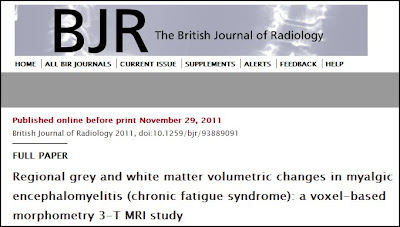November 29, 2011 British Journal of Radiology 2011:
Published online before print November 29, 2011
British Journal of Radiology 2011, doi:10.1259/bjr/93889091
| ||||||||||||||||||||||||||||||||||||||||||||||||||||
FULL PAPER |
Regional grey and white matter volumetric changes in myalgic encephalomyelitis (chronic fatigue syndrome): a voxel-based morphometry 3-T MRI study
1 Department of Imaging, Hammersmith Hospital, London, UK 2 Department of Physical Education and Sport Sciences, University of Limerick, Republic of Ireland 3 University of Hertfordshire, and Care Principles, Rose Lodge, Langley, West Midlands, UK 4 The Ridge Hill Centre, Dudley, UK 5 Brooklands Hospital, Birmingham, West Midlands, UK 6 Broadmoor Hospital, Berkshire, UK 7 Three Bridges Unit, WLMHT, Middlesex, UK 8 National Hospital for Neurology and Neurosurgery, Queen Square, London, UK
Objective: It is not established whether myalgic encephalomyelitis/chronic fatigue syndrome (CFS) is associated with structural brain changes. The aim of this study was to investigate this by conducting the largest voxel-based morphometry study to date in CFS.
Methods: High-resolution structural 3-T cerebral MRI scanning was carried out in 26 CFS patients and 26 age- and gender-matched healthy volunteers. Voxel-wise generalised linear modelling was applied to the processed MR data using permutation-based non-parametric testing, forming clusters at t > 2.3 and testing clusters for significance at p < 0.05, corrected for multiple comparisons across space.
Results: Significant voxels (p < 0.05, corrected for multiple comparisons) depicting reduced grey matter volume in the CFS group were noted in the occipital lobes (right and left occipital poles; left lateral occipital cortex, superior division; and left supracalcrine cortex), the right angular gyrus and the posterior division of the left parahippocampal gyrus. Significant voxels (p < 0.05, corrected for multiple comparisons) depicting reduced white matter volume in the CFS group were also noted in the left occipital lobe.
Conclusion: These data support the hypothesis that significant neuroanatomical changes occur in CFS, and are consistent with the complaint of impaired memory that is common in this illness; they also suggest that subtle abnormalities in visual processing, and discrepancies between intended actions and consequent movements, may occur in CFS.

